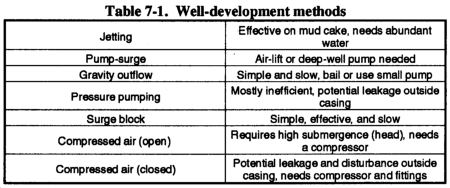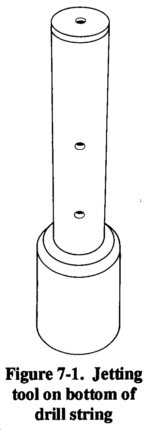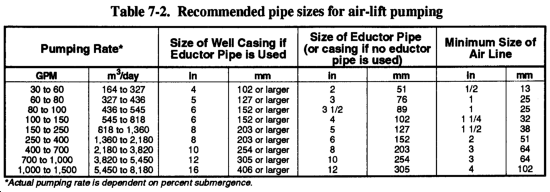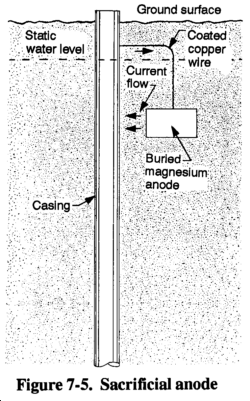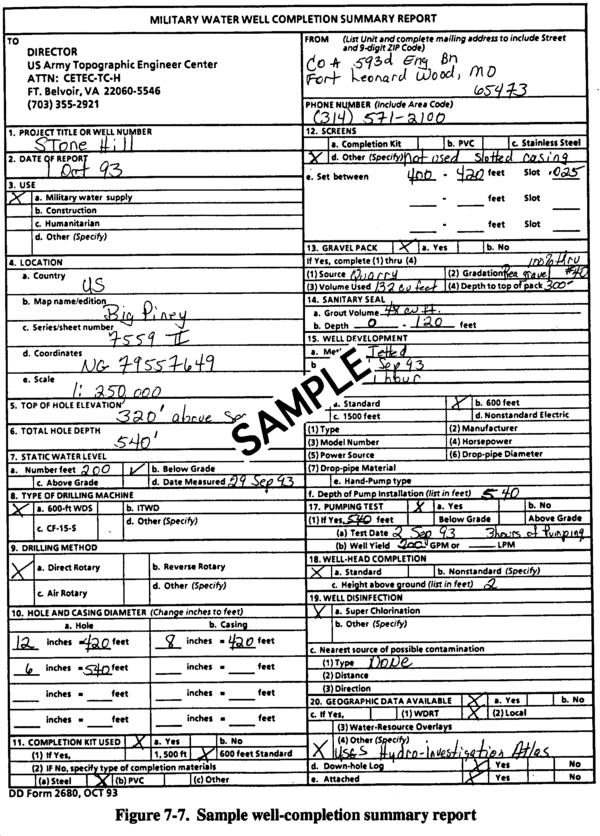Chapter 7
Well-Completion Procedures
|
This Chapter implements STANAG 2885 ENGR. |
7-1. Well Development. Table 7-1 shows the different well-development methods and some characteristics of each method. All methods are designed to produce a stable flow condition. Be careful not to let the drill strike the bottom plug during well development, especially when using PVC pipe.
a. Jetting Method. With this method, you use a jetting tool that you lower inside the screen. Use the following procedures for this method:
- Step 1. Attach the jetting tool (in the well-completion kit) to the bottom of the drill string (Figure 7-l).
- Step 2. Use the string to lower this tool into the screen.
- Step 3. Connect the upper end of the pipe to the kelly or the discharge side of the mud pump.
- Step 4. Pump water into the screen and rotate the jetting tool slowly so that the horizontal jets of water wash out through the screen openings.
- Step 5. Raise the string of pipe gradually and continue rotating to backwash the entire surface of the screen. If possible, use a pump pressure of 100 psi.
This backwashing method is effective in removing caked drilling mud from the borehole wall. A disadvantage in military field operations is that this method requires a large supply of water. After covering the entire screen with the jetting tool, remove the tool. Remove the sand that has collected in the sand trap with a bailer. Repeat this process until the well stops producing sand. If a significant volume of material is removed during development, you should add more filter material around the screen to keep the top of the grovel pack above the top of the screen.
b. Pump-Surge Method. This backwashing technique involves alternately pumping water to the surface and letting the water run back into the well through the pump-column pipe. Use an airlift pump or a deep-well turbine pump without a foot valve. See Chapter 4 for discussions on pumps. Do not use the permanent well pump for development. Pumping sand could damage the pump. Use the following procedure for this method:
- Step 1. Start the pump. As water comes to the surface, stop the pump to release the water. The power unit and starting equipment determine the starting and stopping action of the pump. The effect is to lower and raise the water level in the well intermittently through the screen openings. Periodically, pump the well to remove the sand brought in by surging.
- Step 2. Remove the pump and bail out the material in the sand trap, after surging.
- Step 3. Repeat the process until the well stops producing sand.
c. Gravity-Outflow Method. Backwashing by gravity outflow involves pouring water into the well rapidly to produce outflow through the screen openings. Inflow through the screen is then produced by bailing water from the well rapidly. This is a slow surging technique requiring several minutes to complete a cycle. If the static water level is high enough to permit pumping by suction lift, you can use a small centrifugal pump instead of the bailer to speed up the work. If there is room in the well casing, connect the discharge side of the pump to a string of small diameter pipe that is lowered into the well. The water added is pumped down inside the screen, creating a turbulence that will help to develop the formation.
d. Pressure-Pumping Method. Occasionally, wells are backwashes by capping the casing and pumping water into the well under pressure. Water is forced outward through screen openings similar to the closed-well method of using compressed air for development (paragraph 7-1f(2)). Pressure pumping is an inefficient method because the desirable surging effect is difficult to produce. You must make sure to seal the casing tightly in the borehole and prevent water from being forced up around the outside of the casing.
e. Surge-Block Method. With this method, water is surged up and down in the casing with a surge block or plunger. A surge block can be a solid plunger or swab or a plunger equipped with or without a valve opening (Figure 7-2). The valve-type plunger gives a lighter surging action than the solid type. Light surging is advantageous in developing tight formations. Therefore, start the surging process slowly and increase the force as the development proceeds. Be careful when working with wells using PVC pipe. The casing or well screen could collapse from vigorous surging action. Plugging the valve of the plunger changes it to a solid-type plunger that you can use when you need greater surging force. Attach sufficient weight to the surge plunger to make it fall with the same speed on the downstroke as the drilling machine uses on the upstroke. The drill stem provides the weight required for the surge block. Use the following procedures for the surge-block method:
- Step 1. Lower the surge plunger into the well until it is in the water above the top of the screen. Keep the plunger a few feet above the screen so that it will not strike the screen while surging.
- Step 2. Start surging slowly and gradually increase the speed until the surge plunger rises and falls without slack. With a rotary rig, lift the plunger 3 or 4 feet before dropping it. When using the sand line, control movement by using the hoist brake and clutch.
- Step 3. Continue surging for several minutes. Pull the plunger out of the well and lower the bailer or sand pump into the screen. When the bailer rests on the sand that has been pulled into the screen, check the depth of the sand by measuring on the sand line. Bail all the sand out of the screen.
- Step 4. Repeat the surging operation and compare the quantity of sand with the first quantity. Bailout the sand.
- Step 5. Repeat surging and bailing until little or no sand can be pulled into the well. Lengthen the period of surging as the quantity of sand removed decreases.
f. Compressed-Air Methods. Compressed air provides rapid and effective development of wells, using an open- or closed-well method. You can use the standard 350-cfm compressor for developing most wells at a pressure of at least 100 psi. However, a higher pressure is preferable. The 250-cfm compressor will pump water by air lift from 100 to 150 GPM, depending on the submergence and size of the pipes you use. Table 7-2 shows the recommended sizes of pipe and air lines and the pumping rates you should use for various sizes of wells.
(1) Open-Well Method. The surging cycle is established by pumping from the well with an air lift and by dropping the air pipe suddenly to cut off the pumping. This cycle discharges large bubbles of compressed air into the screen. The submergence ratio must be 60 percent. Submergence is the extent to which the air pipe is submerged in the water compared to the extent the pipe is between water and ground level. Work efficiency decreases rapidly as the submergence ratio drops below 60 percent. In deep wells with a considerable head and a low submergence ratio, you can perform some effective work by shooting heads.
Figure 7-3 shows the proper method of placing the drop pipe and airline in the well. Use a hoist line to easily handle the drop pipe. Suspend the air pipe on the sand line. Fit a T at the top of the drop pipe with a short discharge pipe at the side outlet. Wrap a sack around the air line where it enters the drop pipe to keep water from spraying around the top of the well. Discharge from the compressed air tank to the well should be the same size as or one size larger than the airline in the well. Connect a quick-opening valve in the line near the tank. You need a pressure hose, 15 feet long (minimum), for moving the drop pipe and air line up and down.
Use the following procedures to start developing the well using this method:
- Step 1. Lower the drop pipe to within 2 feet of the bottom of the screen. Place the air line inside the drop pipe with its lower end 1 foot or more above the bottom of the drop line.
- Step 2. Let air enter into the airline and pump the well until the water appears to be free of sand. Start slowly. If all the water is suddenly removed, the casing may collapse in deeper wells, especially when using PVC pipe.
- Step 3. Close the valve between the tank and airline and pump the tank full of air to a pressure of 100 to 150 psi.
- Step 4. Lower the air line until it is about 1 foot below the drop pipe. Open the quick-opening valve so the air in the tank can rush with great force into the well. A brief, forceful head of water will emerge or shoot from the casing and from the drop pipe.
- Step 5. Pull the airline back into the drop pipe immediately after the first heavy load of air shoots into the well. Doing so will cause a revered of flow in the drop pipe that will effectively agitate the aquifer.
- Step 6. Let the well pump as an air lift for a short time and then shoot another head.
- Step 7. Repeat this process until no sand shows, indicating the completion of this stage of development.
- Step 8. Lift the drop pipe to a position 2 or 3 feet higher in the screen and follow the same procedure. This develops the entire length of the screen a few feet at a time.
- Step 9. Return the drop pipe to its original position and shoot one or two more heads.
- Step 10. To complete the development process and thoroughly clean out any loose sand, pull the air line up into the drop pipe and use it as an air lift to pump the well.
(2) Closed-Well Method. With this method, you use compressed air to close the top of the well with a cap and arrange the equipment so air pressure can build up inside the casing to force water out through the screen openings (Figure 7-4).
Disadvantages with this method are--
- That valves and fittings may not be available for military field operations.
- The danger of forcing water upward outside of the casing. This will loosen the casing and could ruin the well by bringing clay down into the formation.
Use the following procedures to develop a well using this method:
- Step 1. Arrange the equipment as in Figure 7-4, and turn the three-way valve to deliver air down the air line, preferably with the air cock open. This will pump water out of the well through the discharge pipe.
- Step 2. When clear water emerges, cut off the air and let the water in the well regain its static level.
- Step 3. Listen to the air escaping through the air cock as the water rises in the casing to determine stability. Close the air cock and turn the three-way valve to direct the air supply down the bypass to the top of the well, forcing the water out of the casing and back through the screen. This technique will agitate the sand and break down any bridging of the sand grains. When the water has been pushed to the bottom of the drop pipe, air escapes through the drop line. You can prevent air logging of the formation by keeping the drop pipe above the well screen.
- Step 4. Cut off the air supply and reopen the air cock so the water can reach the correct static level when you hear the air escaping from the discharge pipe or when the pressure stops increasing.
- Step 5. Turn the three-way valve and direct the air supply down the airline to pump the well.
- Step 6. Repeat this process until the well is thoroughly developed. You should not have to bail the well after developing it because the water velocity usually cleans out the sand from the well. However, if you did not initially bail the well thoroughly, you may have to repeat the bailing process to clean out the well.
7-2. Dispersion Treatment. Dispersing agents, mainly polyphosphates, when added to drilling fluid, backwashing, jetting water, or water standing in the well, counteract the tendency of mud to stick to sand grains. These agents are procured locally on an as-need basis. Baroid Industries produces Barafos, a white, granular, sodium tetraphosphate thinner and dispersant.
You may use chemicals such as sodium hexametaphosphate, tetra sodium pyrophosphate, sodium tripolyphosphate, and sodium septaphosphate to develop wells. Dispersants work effectively when applied at the rate of one-half pound of chemical to 100 gallons of water in the well. Let the mixture stand for about one hour before starting well development. Wetting agents, such as CON DET, increase the dispersion action of polyphosphates when added to the solution at a ratio of 1:100. Be careful when using the dispersion process because you could have an adverse reaction. The driller should make the decision to use or not to use dispersants.
7-3. Rock Development. Use this method to develop wells in rock formations. You can obtain good results by combining jetting with air-lift pumping from a limited zone isolated by inflatable packers. The objective is always to wash out fine cuttings, silt, and clay that have worked into the fissures, crevices, or pores of the rock during the drilling operations. Openings that remain plugged reduce water flow into the well. Develop the well thoroughly to remove all obstructing material. When drilling through limestone formations, use acid to dissolve lime-like cementing material and to open up connections with joints or fissures beyond the borehole wall. However, such operations are rare in military well drilling.
7-4. Well Protection and Treatment
a. External Preparations. You should disinfect and protect a well before starting the borehole. Some other preventive measures are--
- Stopping surface contaminants from entering the well.
- Ensuring that the drilling water's quality is suitable.
- Cleaning and disinfecting all drilling equipment before starting a new well.
- Disinfecting the water used for drilling if you use a mud-based drilling fluid. If you use a synthetic drilling fluid, chlorinate the fluid. However, doing so will break down the fluid and reduce its life.
- Circumventing possible water-quality problems by stopping potentially harmful fittings and equipment from entering the borehole. Carefully check the list of the hardware and materials placed and left in the well.
NOTE: Well casings should extend no more than 12 inches above the pump-house floor on a final-grade elevation and not less than 12 inches above the normal anticipated flood level.
b. Sealing Casing. A well must be carefully protected from sewage and other contaminants that could migrate down the well column to the aquifer and well screen. Sources of pollution could be on the surface or in shallow perched water, unusable aquifers, and intermittently saturated beds. Carefully planning the well's location could help avoid the surface sources. However, you may not know about subsurface contaminants until you start drilling the well. If that occurs, you will have to alter plans and seal the well quickly. Chapter 6 discusses sealing or grouting operations. See STANAG 2885 ENGR (Edition 2) for sealing a NATO well.
A rock well may be grouted from the lower end of the casing to the surface. You can place grout between the inner and outer casings and around the inner casing in a portion of the drilled borehole below the outer casing. Make sure that overburden does not seal the borehole after you set the casing.
c. Disinfection. All newly constructed wells should be considered contaminated from the construction process and disinfected immediately after completion. Well-completion kits provide packages of a dry chlorinator for breaking down synthetic drilling fluids to disinfect the wells. Prepare a chlorine solution by--
- Mixing 1 heaping tablespoon of calcium hypochlorite with water to make a thin paste. Break up all lumps.
- Stirring mixture into 1 quart of water. Let the mixture stand a short time.
- Pouring off the clear liquid.
The chlorine strength of the solution is about 1 percent. One quart of the liquid is enough to disinfect 1,000 gallons of water. Larger quantities of the solution may be prepared in the same proportion and, if placed in sealed containers (preferably glass), can be stored for several years without losing its effectiveness.
Estimate the volume of water standing in the well. Pour in the corresponding ratio of solution to gallons of water in the well. (For safety, use less solution than too much solution.) Agitate the water in the well thoroughly and let it stand for several hours, preferably overnight. Flush the well to remove all of the disinfecting agent. You can disinfect the well casing by returning water to the well during the early stage of flushing and washing the walls with chlorinated water.
d. Cathodic Protection. A sacrificial anode (Figure 7-5) is the simplest method of protecting metal casing from corrosion. Connect a galvanically active metal bar, such as magnesium- coated wire, to the casing. Bury the anode bar near the casing below the water table. In this cell, ions flow to the casing through the groundwater. While the anode corrodes, the casing remains unaffected. Another method is to suspend cable (acting as the anode) into the well. The anode continues to operate and protect the casing until it is consumed. (Periodically replace the anodes as continuing maintenance.)
e. Well Head and Collar. Use the well head in the well-completion kit; otherwise, extend the casing at least 1 foot above the general level of the surrounding surface. Seal the space around the outside of the casing by pouring a concrete platform around the casing at the surface (Figure 7-6). To form a concrete platform, you will need the following bill of materials (BOM):
- Two 2-inch by 10-inch by 8-foot boards. Cut these in half for the walls.
- Eight 2-foot long No. 4 reinforcement bars for the comer stakes.
- One 4-by 4-foot wire mesh.
- About 0.5 cubic yard of concrete.
Use the following procedures to make the platform:
- Step 1. Clear the site with shovels.
- Step 2. Dig a 4-inch excavation.
- Step 3. Construct the form.
- Step 4. Place the wire mesh, snipping out the center for the casing pipe.
- Step 5. Mix and pour the concrete quickly.
- Step 6. Pull the wire mesh up through the concrete.
- Step 7. Screed with a 2-inch by 4-inch by 8-foot board.
If you do not have a container to mix the concrete, construct a mortar box using the following materials:
- One 4-foot by 8-foot by 1/2-inch piece of plywood for the base.
- Four 2-inch by 6-inch by 8-foot boards for the walls.
- One 2-inch by 4-inch by 8-foot screed beam.
NOTE: When mixing concrete, add the water slowly. Use 5 gallons of water per sack of concrete. Mix it with a hoe and place the concrete quickly.
The upper surface of this slab and its immediate surroundings should be gently sloping so water will drain away from the well. You should also place a drain around the outer edge of the slab and extend it to a discharge point that is far away from the well. A well with pipe casing should have a sanitary seal at the top that fills the space between the pump pipe and the well casing. This device consists of a bushing or packing gland that makes a watertight connection.
7.5 Well-Completion Report. Figure 7-7 is an example of a military water well completion summary report (DD Form 2680). This form is used to update the world-wide resource data base. After you complete all well-drilling operations, fill out the form and send to the address on the form. DD Form 2680 is in the back of this manual for reproduction and use.
|
NEWSLETTER
|
| Join the GlobalSecurity.org mailing list |
|
|
|


